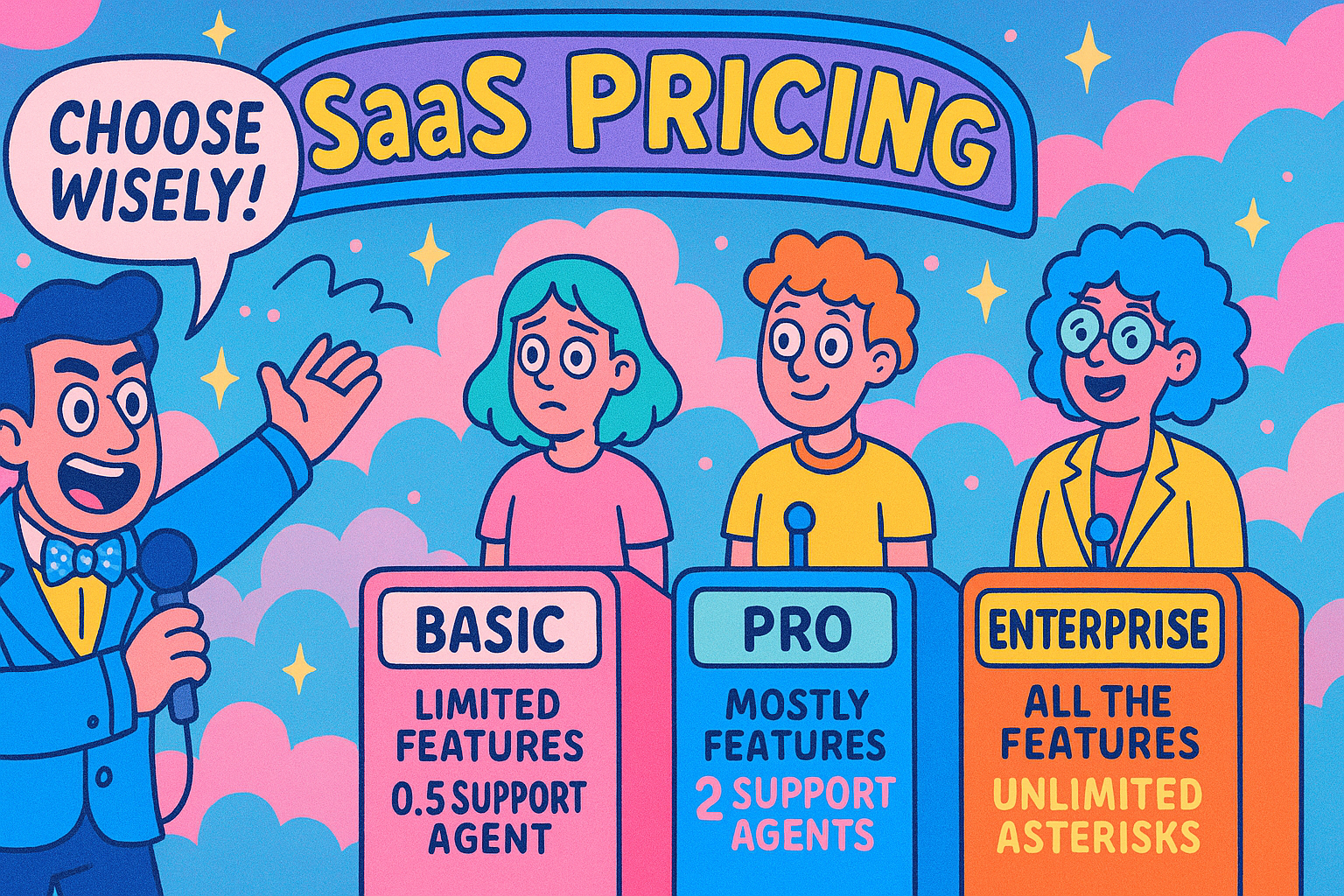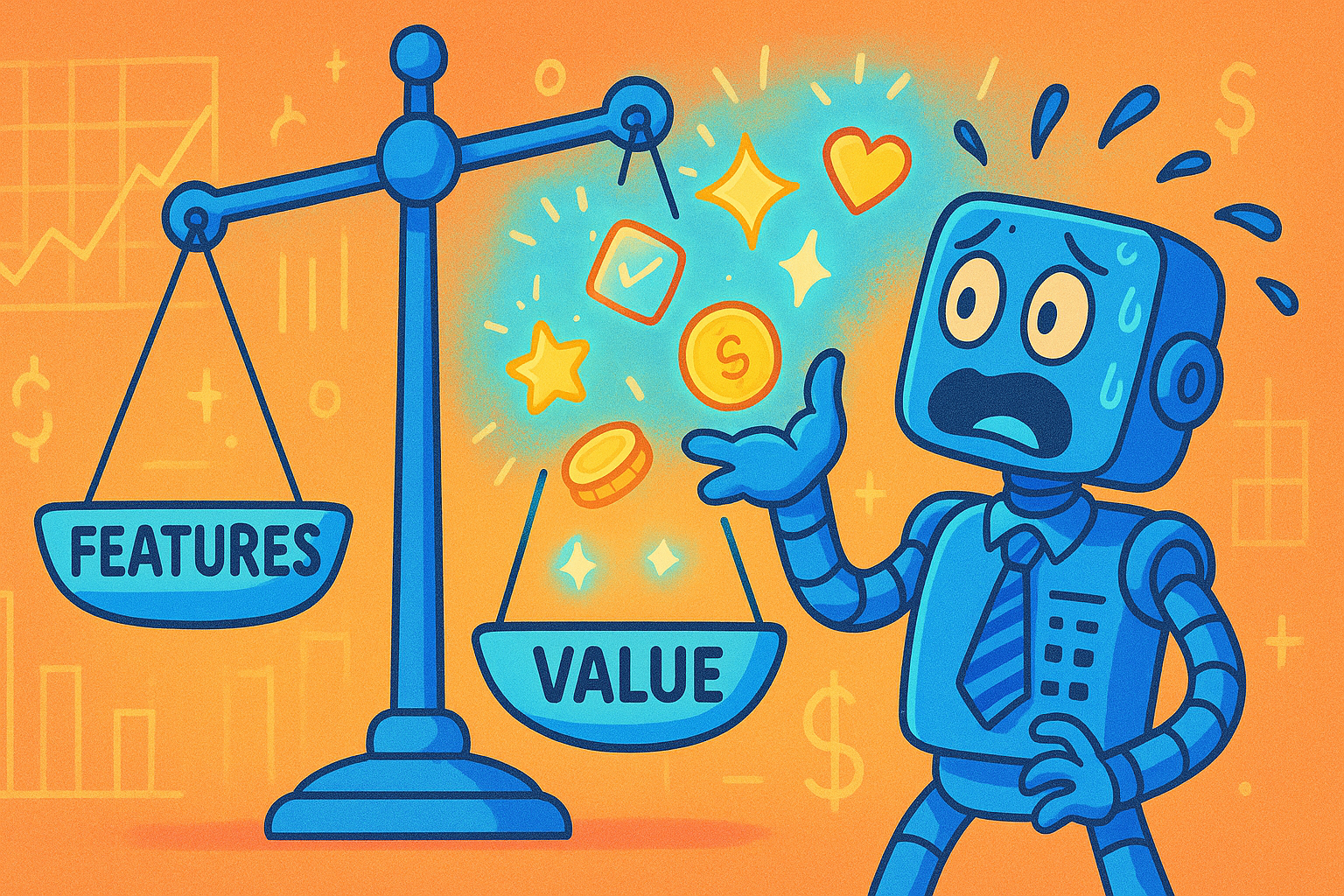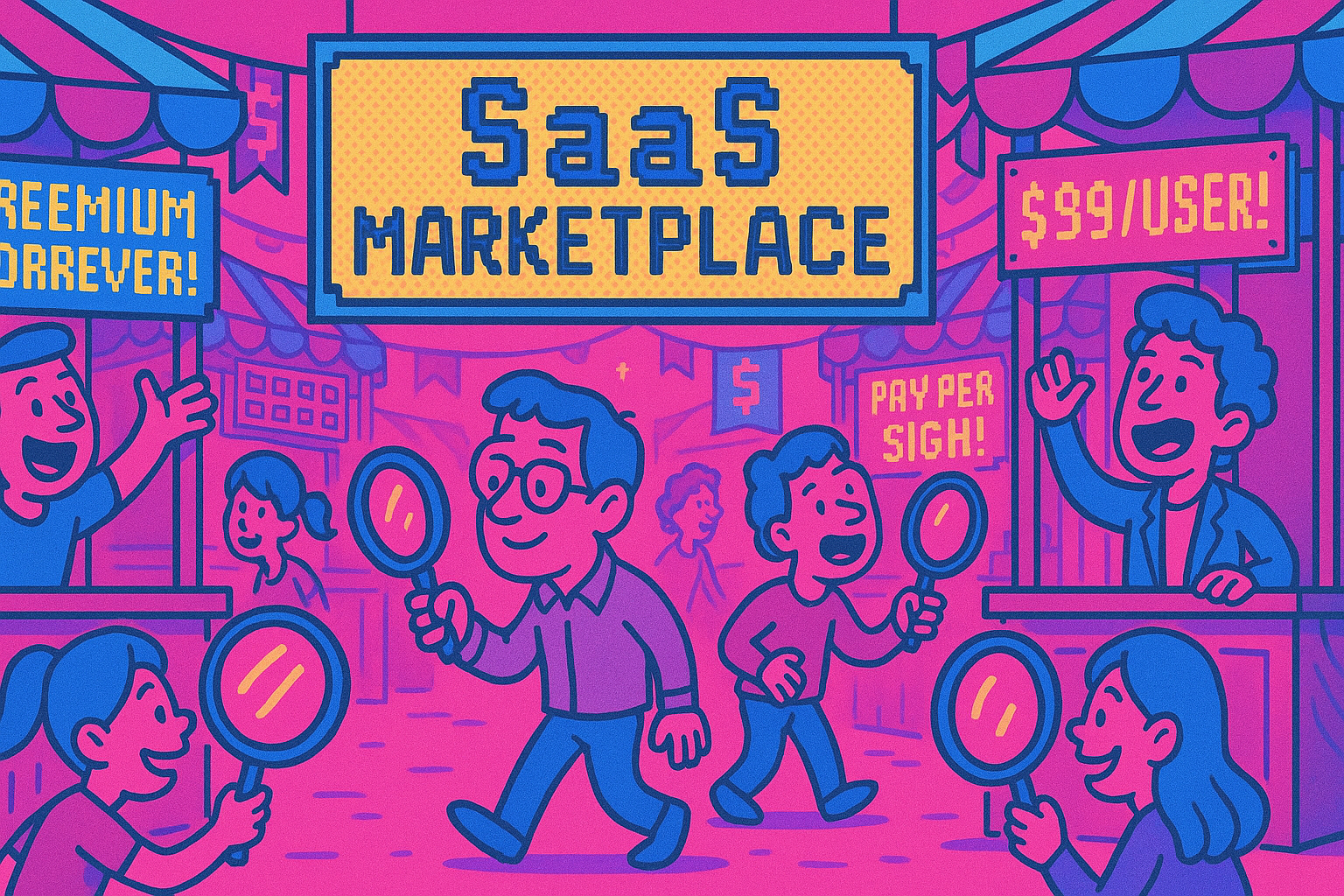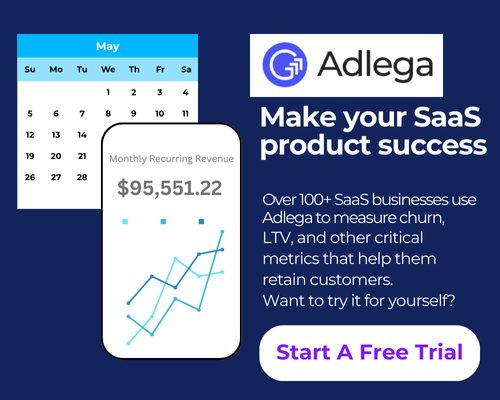
93% of SaaS companies spend less than 6 hours on their pricing strategy throughout their entire business lifetime, yet pricing impacts every aspect of growth—from customer acquisition to retention to profitability. Poor pricing decisions can cripple even the most innovative products, while strategic pricing becomes a competitive moat that drives sustainable revenue growth.
An effective SaaS pricing strategy combines value-based pricing with the right model (subscription, usage-based, or hybrid), psychological tactics like anchoring and decoy pricing, and continuous optimization based on customer feedback and market data to maximize revenue while delivering clear value to customers.
What is SaaS Pricing Strategy and Why It Matters
A SaaS pricing strategy is your comprehensive approach to determining how much customers pay for your software, when they pay, and how that payment structure aligns with the value you deliver. However, it goes far beyond simply slapping a price tag on your product.
Your pricing strategy encompasses three critical elements: the pricing model that determines payment structure, the actual price points that customers see, and the psychological tactics that influence purchasing decisions. Together, these elements create a powerful framework that can make or break your business.
The impact extends throughout your entire SaaS business model. Strategic pricing directly influences customer acquisition costs, lifetime value, churn rates, and ultimately your path to profitability. Companies with optimized pricing strategies see 30% higher revenue growth compared to those using basic cost-plus models.
Most founders make critical mistakes early on. They either price too low, leaving substantial revenue on the table, or price too high, creating unnecessary barriers to adoption. Furthermore, many treat pricing as a one-time decision rather than an ongoing optimization process that should evolve with your product and market understanding.
The Three Core Pricing Strategies for SaaS
Every SaaS pricing decision ultimately falls into one of three strategic approaches. Understanding these frameworks helps you make informed choices rather than pricing by instinct.
Cost-Plus Pricing (Why It Fails for SaaS)
Cost-plus pricing involves calculating your expenses and adding a profit margin. For example, if your costs are $50 per customer and you want 40% profit, you’d charge $70. While this approach works for physical products with clear production costs, it’s problematic for software.
SaaS products have high upfront development costs but minimal marginal delivery costs. Your variable costs might be $5 per customer while your fixed costs include substantial engineering and infrastructure investments. Cost-plus pricing ignores the value you create and often results in significant underpricing.
Moreover, cost-plus pricing treats all customer segments equally, missing opportunities to capture more value from enterprise clients who derive greater benefits from your solution.
Competitor-Based Pricing (Good Starting Point)
Competitor-based pricing uses market rates as your benchmark. You research what similar solutions charge and position yourself above, below, or at market level based on your competitive advantages.
This strategy works well for new companies without extensive customer data. It provides a reality check and ensures you’re not completely out of line with market expectations. However, blindly copying competitors can be dangerous—you don’t know their cost structure, customer value realization, or strategic objectives.
The key is using competitive intelligence as one data point, not your primary decision driver. Look at competitors to understand market ranges, then adjust based on your unique value proposition and business fundamentals.
Value-Based Pricing (The Gold Standard)
Value-based pricing ties your price directly to the economic value customers receive. If your CRM software helps a sales team close $100,000 more revenue annually, charging $10,000 per year represents excellent value for the customer.
This approach requires deep customer understanding but offers the highest revenue potential. You’re not limited by your costs or competitor prices—instead, you’re constrained only by the value you create. Companies using value-based pricing typically achieve 20-30% higher profit margins than those using cost-plus approaches.
Value-based pricing also aligns your success with customer success, creating sustainable business relationships. When customers clearly see ROI, they’re more likely to expand usage, renew subscriptions, and become advocates.
SaaS Pricing Models: Choosing the Right Structure
Your pricing model determines how customers pay for your software. The right model depends on your product’s usage patterns, customer preferences, and business objectives. Let’s explore the main options and their strategic implications.
Subscription-Based Pricing (Tiered Plans)
Subscription models charge customers a recurring fee for continued access to your software. Most SaaS pricing models use tiered subscriptions with multiple plan levels targeting different customer segments.
The classic three-tier approach includes a basic plan to capture price-sensitive customers, a premium plan that most customers choose, and an enterprise plan for large organizations. This structure leverages psychological principles while accommodating diverse customer needs.
Subscription pricing provides predictable revenue and easier forecasting. Customers appreciate knowing exactly what they’ll pay each month, which reduces purchase friction. However, you must carefully balance features across tiers to encourage upgrades without making lower tiers feel inadequate.
Annual subscriptions often work better than monthly for SaaS companies. They improve cash flow, reduce churn decisions from 12 times per year to once, and typically command a discount that customers appreciate while still providing better unit economics.
Usage-Based Pricing (Pay-as-You-Go)
Usage-based pricing charges customers based on their actual consumption of your service. This model works exceptionally well for infrastructure software, API-based services, and tools where usage directly correlates with customer value.
The biggest advantage is perfect value alignment—customers pay more when they use more, which typically means they’re deriving more value. This reduces sales friction since customers don’t worry about overcommitting to a plan they might not fully utilize.
However, usage-based pricing creates revenue unpredictability and can be difficult for customers to budget. Some customers prefer spending certainty even if it means potentially paying more overall.
Companies like Twilio and AWS have proven this model works at scale, but it requires robust usage tracking infrastructure and clear, understandable pricing units that customers can easily predict and control.
Hybrid Models (Best of Both Worlds)
Hybrid models combine subscription and usage-based elements. For example, you might charge a base subscription fee that includes certain usage limits, then charge additional fees for overage.
This approach provides revenue predictability while maintaining value alignment. Customers get budget certainty for their baseline usage while paying more only when they exceed those limits. It’s particularly effective for services with variable usage patterns.
The complexity is higher than pure models, so ensure your pricing remains easy to understand and predict. Customers should never be surprised by their bills.

Pricing Psychology: The Science Behind Effective Price Points
Human psychology plays a massive role in purchasing decisions. Understanding and applying behavioral principles can significantly impact your conversion rates and revenue without changing your actual prices.
Anchoring and Decoy Pricing
Anchoring occurs when people rely heavily on the first piece of information they encounter. In pricing, this means the first price customers see influences their perception of all subsequent prices. Therefore, leading with your highest-priced plan can make other options seem more reasonable.
Decoy pricing takes this further by introducing a plan specifically designed to make another plan look attractive. If your premium plan costs $100 and your enterprise plan costs $300, adding a “professional” plan at $250 with fewer features makes the enterprise plan seem like better value.
The decoy doesn’t need to sell—its purpose is steering customers toward your preferred option. This tactic works because customers don’t just evaluate absolute value; they compare options against each other.
Loss Aversion in Subscription Decisions
People hate losing something more than they enjoy gaining something equivalent. In SaaS, this means customers fear losing productivity, data, or capabilities more than they desire new features.
Frame your pricing communications around what customers keep rather than what they gain. Instead of “Upgrade to get advanced analytics,” try “Don’t lose insights that could improve your ROI.” This approach is particularly powerful for renewal conversations and upgrade campaigns.
Free trials leverage loss aversion effectively. Once customers experience your software’s benefits, the thought of losing that capability motivates subscription purchases more than traditional sales approaches.
The Power of Perceived Value
Price itself influences perceived value. In B2B software, higher prices can actually increase demand by signaling quality, reliability, and enterprise readiness. This is why some companies find that raising prices improves conversion rates.
However, perceived value must align with actual value delivery. If customers pay premium prices but don’t experience premium results, churn becomes inevitable regardless of initial conversion rates.
Build perceived value through professional presentation, comprehensive onboarding, responsive support, and clear ROI communication. Customers should feel confident that your premium pricing reflects premium quality.
Building Your Pricing Strategy: Step-by-Step Framework
Creating an effective pricing strategy requires systematic analysis rather than guesswork. Follow this framework to build pricing that drives growth while maintaining profitability.
Step 1: Understand Your Customer Value Proposition
Start by identifying exactly how your software creates value for different customer segments. Interview existing customers to understand their ROI, time savings, revenue increases, or cost reductions attributable to your solution.
Develop detailed customer personas that include not just demographics but value realization patterns. A small business might save $5,000 annually through your automation, while an enterprise saves $500,000—this difference should inform your pricing tiers.
Quantify value wherever possible. Vague benefits like “improved efficiency” become compelling when expressed as “reduces manual work by 15 hours per week.” Concrete value metrics make pricing conversations much easier.
Step 2: Analyze Your Unit Economics
Understand your unit economics to ensure pricing supports sustainable growth. Calculate your customer acquisition cost, lifetime value, gross margins, and payback periods for different customer segments.
Your pricing must support healthy unit economics. If acquiring a customer costs $1,000 but they only pay $500 annually with 20% churn, you have a fundamental business model problem that pricing alone can’t solve.
Model different pricing scenarios to understand their impact on key metrics. Higher prices might reduce conversion rates but improve unit economics if the lifetime value increase more than compensates for lower volumes.
Step 3: Research Market Positioning
Analyze competitor pricing not to copy it, but to understand market dynamics and positioning opportunities. Look for gaps where you can offer superior value at competitive prices or justify premium pricing through differentiation.
Consider market maturity. In emerging categories, customers may need education about value before accepting higher prices. In mature markets, differentiation becomes crucial for commanding premium rates.
Don’t ignore adjacent markets either. If customers currently solve your problem through manual processes or alternative solutions, factor those costs into your value proposition and pricing decisions.
Step 4: Design and Test Your Pricing
Start with a hypothesis based on your value analysis, unit economics, and market research. Design 2-3 pricing options that target different customer segments while maintaining clear differentiation between tiers.
Test your pricing with prospects and existing customers before full implementation. Customer feedback often reveals perception gaps between your intended positioning and market reality.
Consider soft launches to subset of customers or specific market segments. This approach lets you gather real purchasing behavior data while limiting downside risk if adjustments are needed.
Pricing Optimization: Metrics and Continuous Improvement
Pricing isn’t a set-and-forget decision. Continuous optimization based on data and customer feedback drives long-term revenue growth and competitive advantage.
Track key metrics that indicate pricing health. Monthly recurring revenue (MRR) shows overall revenue trends, while average revenue per user (ARPU) indicates whether you’re capturing increasing value per customer.
Monitor churn rates across different pricing tiers to identify optimal price points. If premium tier customers churn significantly more than basic tier customers, you might be pricing beyond perceived value.
Expansion revenue metrics reveal whether customers are growing their usage over time. Healthy SaaS businesses see negative churn, where expansion revenue from existing customers exceeds revenue lost from churned customers.
A/B testing remains the gold standard for pricing optimization. However, test thoughtfully—price tests can impact customer relationships, so ensure you have sufficient sample sizes and run tests long enough to capture true behavior patterns.
When raising prices, give existing customers advance notice and grandfathering options. Price increases can drive short-term revenue spikes, but maintaining customer relationships ensures long-term sustainability.

Common SaaS Pricing Mistakes to Avoid
Learning from others’ mistakes can save you significant revenue and customer relationship damage. These common pricing errors plague many SaaS companies, but they’re entirely avoidable with proper planning.
Under-pricing is perhaps the most common mistake, especially among technical founders who undervalue their own work. If you’re consistently closing 90% of prospects without price objections, you’re probably leaving money on the table. Healthy businesses see some price resistance—it indicates you’re testing the value ceiling.
Over-complicating pricing confuses customers and creates sales friction. If you need a spreadsheet to explain your pricing, it’s too complex. Customers should understand their costs within 30 seconds of viewing your pricing page.
Ignoring customer feedback about pricing leads to preventable churn and missed expansion opportunities. Regular pricing surveys and win/loss interviews provide invaluable insights about price sensitivity and value perception.
Failing to consider customer lifetime value in pricing decisions optimizes for the wrong metrics. A slightly higher price that attracts customers with longer lifespans often produces better unit economics than lower prices that attract price-sensitive churners.
Finally, treating pricing as immutable after launch prevents optimization and growth. Markets evolve, features improve, and customer value realization changes—your pricing should evolve accordingly.
Real-World SaaS Pricing Examples and Case Studies
Successful pricing strategies vary dramatically across different SaaS categories, but certain patterns consistently drive growth and profitability.
Freemium models work exceptionally well for products with network effects or where usage correlates strongly with value. Slack’s freemium approach captured millions of users, then converted teams as they hit message history limits. The key was providing genuine value in the free tier while creating natural upgrade triggers.
Enterprise pricing strategies often use value-based approaches with custom pricing for large deals. Salesforce doesn’t publish enterprise pricing because each implementation delivers different value levels. This approach requires skilled sales teams but maximizes revenue from high-value customers.
Usage-based pricing success stories like Twilio demonstrate how aligning pricing with customer success creates sustainable growth. As customers’ businesses grow and they send more messages or process more payments, Twilio’s revenue grows proportionally. This alignment encourages customer success rather than creating value conflicts.
Focus on account expansion strategies and effective upselling approaches to maximize revenue from existing customers. Many successful SaaS companies derive 70% or more of their revenue growth from expansion rather than new customer acquisition.
The most successful pricing strategies share common elements: clear value propositions, simple presentation, alignment between price and value delivered, and continuous optimization based on customer feedback and business metrics.
Start Building Your Winning Pricing Strategy
Effective SaaS pricing strategy combines art and science, requiring deep customer understanding, solid business fundamentals, and psychological insights about purchasing behavior. The companies that invest time in strategic pricing decisions consistently outperform those that treat pricing as an afterthought.
Remember that pricing is never perfect from day one. Start with the best information available, then optimize continuously based on customer feedback and business metrics. The goal isn’t finding the perfect price—it’s building a pricing framework that evolves with your business and maximizes long-term value creation.
Your pricing strategy should reinforce your overall business strategy while remaining flexible enough to adapt as markets and customer needs change. Done well, strategic pricing becomes a competitive moat that’s difficult for competitors to replicate.
Ready to transform your financial planning and pricing analysis? Start a free Adlega forecast now to model different pricing scenarios and understand their impact on your business metrics.

Leave a Reply